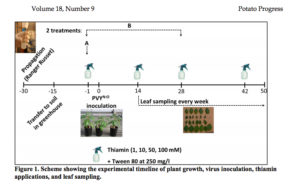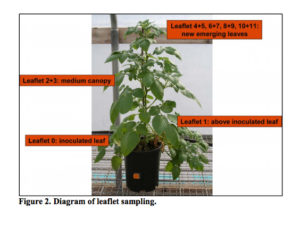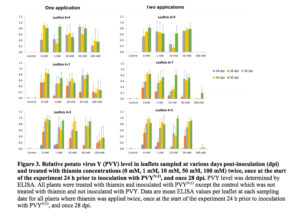Aug 2, 2018Investigating vitamin B1 as a tool for managing PVY
This article originally appeared in Potato Progress, which compiles research and Extension work for the potato industry from Idaho, Oregon and Washington.
Potato has a plethora of diseases including bacteria, fungi, viruses and nematodes. Potato productivity and production also can be compromised by arthropod pests. It is estimated that losses due to plant diseases alone can cost about $10 billion per year (16 percent of potential production).
Learning about how to control diseases and vectors is a major concern to the potato industry. Most control methods available to growers kill or minimize the presence and effect(s) of either the pathogen or the vector. However, there is increasing pressure to decrease the use of chemicals to reduce non-target effects, reduce impact on the environment including protecting soil health, food safety and workers. Therefore, there is a need to search for alternative control measures. One such measure is the use of plant immunity inducers (PIIs). PIIs are immune-active compounds that can induce resistance in plants, in a similar way to vaccines in animals.
There are two categories of PIIs: (1) non-biologically active molecules that are synthetic plant defense elicitors such as jasmonic acid analogs; and (2) biologically active molecules, which naturally occur in nature, mostly in plants but also in microorganisms. They include different categories of molecules such as metabolites, oligosaccharides, proteins, lipids and microbial inducers. Some of the most recently discovered PIIs are vitamins, in particular B vitamins. There are several reports in the literature on the priming effect of, for instance, riboflavin in tobacco, rice and bean, thiamin on rice, cucumber, tobacco, soybean, and grapevine, and folic acid in Arabidopsis Thiamin also has a repellant effect on aphids in barley.
To our knowledge, there is no literature available that evaluates the efficiency of vitamins in potato. Thus, motivated by this lack of information, we decided to test the effect of thiamin (also known as vitamin B1) application against potato virus Y (PVY). The study focused on evaluating the effect of thiamin concentrations and frequency of applications on disease expression.
What we did
The following controlled study was done at the Oregon State University Hermiston Agricultural Research and Extension Center in Hermiston, Oregon, in a greenhouse. We used disease-free Ranger Russet plantlets that we propagated in tissue culture before transferring them to soil in pots (Figure 1). 
Two treatments were included: A, one application of thiamin one day before PVY inoculation; B: two applications (one application one day before PVY inoculation and one 28 days after PVY inoculation). We had four different concentrations of thiamin, sprayed until run off in spray bottles with Tween 80 as surfactant. We inoculated plants with PVY N:O because this strain produces clear foliar symptoms in Ranger Russet. After inoculation, we collected leaf samples every week starting 2 weeks after PVY inoculation.

We sampled leaves as shown in Figure 2. Leaflet 0 was the initial inoculated leaf. We sampled the leaf just above (leaflet 1), then mid-canopy leaflets (2+3), and new emerging leaflets (4+5, and as the plants kept growing we had new emerging leaves that we also sampled 6+7, 8+9 etc.). We used ELISA to detect the virus and quantify the level of virus in the plants. We confirmed our ELISA results by using another quantification method, Real Time quantitative RT-PCR (qPCR).

What we found
Figure 3 shows the virus level in the youngest sampled leaflets based on the concentration of thiamin applied over time for one or two applications. The control was PVY-free and no thiamin treatment. All the others plant/treatments were inoculated with PVY and treated with either no thiamin or 1, 10, 50 and 100 mM thiamin. At 14 dpi, we could detect the virus when there was no thiamin or 1 mM thiamin applied, but not with higher concentrations. At 26 dpi, there was lower virus level when plants were treated with 100 mM thiamin compared to the no thiamin treatment control. This trend becomes more obvious at 35, 43 and 50 dpi. The most significant decrease in virus level was when plants were treated with two applications of thiamin at a concentration of 100 mM; in this case, the virus was not or barely detectable.
Conclusions
In this study, we showed that thiamin application at 100 mM significantly lowered the PVY titer throughout the plant, and two applications produced the best results. This experiment was done under controlled conditions using only one variety. Future research should determine whether thiamin application has the same effect on other commercial potato varieties and whether the economics of using this promising alternative method of control benefits the bottom line of growers’ production. Our study is the first report on testing vitamins in potatoes and could serve as a model in other cropping systems. The use of this alternative way of pathogen/disease control would not replace existing control method, but would complement current practices for a more sustainable production.
– Aymeric Goyer, Department of Botany and Plant Pathology, Hermiston Agricultural Research and Extension Center
-Silvia I. Rondon, Department of Crop and Soil Sciences, Hermiston Agricultural Research and Extension Center Oregon State University







